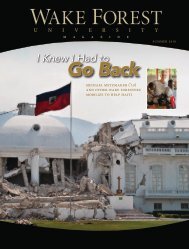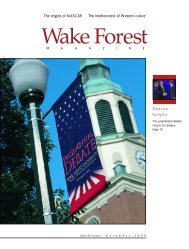Wake Forest Magazine September 2003 - Past Issues - Wake Forest ...
Wake Forest Magazine September 2003 - Past Issues - Wake Forest ...
Wake Forest Magazine September 2003 - Past Issues - Wake Forest ...
You also want an ePaper? Increase the reach of your titles
YUMPU automatically turns print PDFs into web optimized ePapers that Google loves.
PHOTOS BY LOUIS DAVISmuch higher risk of health problems anddeath than other newborns; and prematurity/lowbirth weight is one of thecostliest reasons for a hospital stay.Meis hasn’t needed facts like these tocomprehend the cost and heartbreak ofpremature birth. He has witnessed themtime and time again over a forty-yearcareer of administering prenatal, delivery,and postnatal care to thousands of mothersand their babies. He calls it “the biggestproblem in obstetrics” and has devotedhimself to combating it.Born in Sioux City, Iowa, and trainedin medicine at the University of Iowa, hestarted practicing obstetrics in Wisconsinin the early sixties, at a time when thatstate began developing a regional perinatalcare network, with special focus ondelivering neonatal care to prematureinfants and high-risk mothers. Inspired,he decided to specialize in maternal fetalmedicine, and after a fellowship at Harbor/UCLA Medical Center in Los Angeles,he joined the <strong>Wake</strong> <strong>Forest</strong> medical facultyin 1977.Meis’ early efforts at combating prematurityconcentrated on a combinationof education, early intervention (sometimesinvolving bed rest), and the stopping ofpreterm labor.Through a grant, he,another physician, and a nurse associatespent three years working with at-riskwomen at hospitals and doctor’s officesacross northwest North Carolina. “Theresults were disappointing,” Meis says.“We really didn’t see any change.” Aboutthe only pharmaceutical options, then aswell as now, were tocolytic drugs, whichinterrupt labor. “Unfortunately, thosedon’t work too well,” he notes. “They’llstop labor, but only for twenty-four toforty-eight hours.”A determined Meis turned his focusto the epidemiology, or root causes, ofprematurity. In 1990 he spent threemonths on sabbatical at the Universityof Wales College of Medicine, whichmaintains an extensive birth database.Drug use, infection, multiple births, andsmoking emerged statistically as factors,but he uncovered no conclusive “smokingguns.” He resolved to keep looking andbecame active in the Society for Pediatricand Perinatal Epidemiologic Research,eventually serving a term as its president.Around the time of his Wales trip, theNational Institutes of Health establishedthe Maternal Fetal Medicine Units Network[MFMU], a consortium of about a dozenmaternal and fetal medicine centersacross the country for the purpose ofpursuing collaborative research protocols.With more than 120,000 combined livebirths a year at its institutions, the MFMUhas a huge subject base for studies. It hasbeen the primary locus of Meis’ researchactivities for the past dozen years.Back when Meis and his colleagueswere barnstorming the northwest part ofthe state, premature-birth researcherselsewhere had begun conducting smallclinical trials of a form of progesteronecalled 17-alpha-hydroxyprogesteronecaproate, or 17P, for short. Progesteroneis a natural hormone produced duringpregnancy by, first, the ovaries to sustaina pregnancy in its first ten to twelveweeks, and then in large quantities by theplacenta to relax the uterine muscles,which contract to induce birth. “Earlytrials with pills and injections [of 17P]attracted interest, but no one did a definitivelarge randomized trial,” Meisrecalls. “Then, for some reason, interestfaded, and it was not widely used. I hadbeen interested in it, but by that time the“We are thrilled,” NancyGreen, the March ofDimes medical director,said. “We may be at thethreshold of discovery ofa new and effectivemeans of prevention.”patent had expired and there was nofunding available from the manufacturer.”When Meis proposed a large-scale,randomized study of 17P to MFMU in1995, some were initially skeptical. “Oneof our members, a respected researcherwho had been our chairman, called itridiculous,” Meis recalls. “He said,‘Theplacenta produces buckets of the stuff.Why would a little more make any difference?’That’strue. But it does.” Meisprevailed, and the MFMU made plans tolaunch a nationwide study. At that timeone drug company was making 17P, butjust as the study was about to get underway,the Food and Drug Administrationshut down the company and recalled allstocks of the drug, including the MFMU’s.Undaunted, the group commissionedanother company to manufacture it andrestarted the study with 463 high-riskwomen subjects.The women in the study were allpregnant with one fetus; their only knownrisk factor was a history of having givenbirth prematurely, but that put them inthe very highest risk group.Two-thirds ofthe subjects were given weekly injections<strong>September</strong> <strong>2003</strong> 17
















